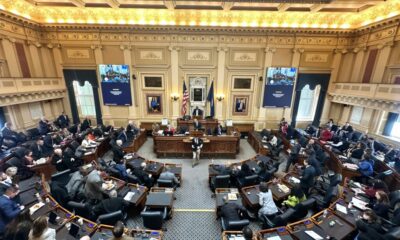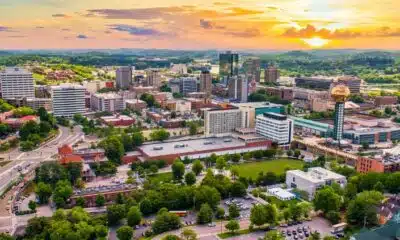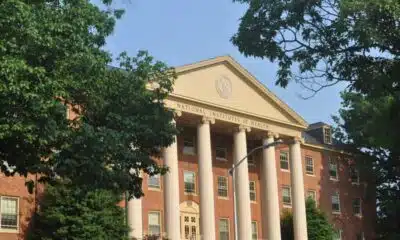News from the South - North Carolina News Feed
Wilmington growth spurt sparks worries over loss of land, identity
WILMINGTON — This was once a quaint, coastal town, all cobblestone and sand dunes. When Wilmington Mayor Bill Saffo graduated from high school in 1978, the vast majority of the graduating class hightailed it out of here as fast as they could. There were no jobs and no prospects.
Now, it’s bursting at the seams with businesses and opportunities.
[Subscribe for FREE to Carolina Public Press’ alerts and weekend roundup newsletters]
How to manage this influx of people — many from the northeastern United States — is a topic of debate.
It’s also a question whose answer will shape the city’s future.
No room to grow in Wilmington
Just 192 square miles of land, New Hanover County, home to Wilmington, is surrounded on three sides by water: the Cape Fear River and the Atlantic Ocean. Nearly every last corner of the peninsula is developed. There’s nowhere for the city to grow.
As a result, bedroom communities in Brunswick County to the south have exploded in recent years, making it the fastest-growing county in the state at 22% growth between 2020 and 2024. Pender County, immediately to the north of Wilmington, ranked second.
While the population burst has created more economic and cultural opportunities in Wilmington and the surrounding area, there are those worried about the loss of the region’s wetlands and forests as well as its sense of identity.
To others, Wilmington’s booming populace should be celebrated instead of criticized.
“There is no such thing as overdevelopment,” said Cameron Moore, president of the Wilmington Home Builders Association. “It’s all in the eye of the beholder. I’m not going to apologize for the fact that the city is growing.”
The pandemic brought hoards of people who found remote work and realized they could live anywhere. The region is becoming ever more popular with retirees. UNC-Wilmington is the fastest-growing school in the UNC System.
All that leads many to wonder if the city’s infrastructure — schools, roads and medical systems — can support this rapid growth.
Survey says
A survey in 2023 found that 55% of Wilmington residents cited growth and development as their primary concerns about living in the city, followed by traffic congestion and affordable housing.
But opinions on growth vary widely.
Some are happy that Wilmington is booming.
“I’d rather live in a community that’s growing and thriving, a place where people want to be,” said Liz Carbone, an affordable housing consultant, “rather than in a rural community, like some of our neighbors in North Carolina, where their communities are dying, people are actively moving away, property values are plummeting, jobs are drying up and there’s no tax base to do anything inventive or helpful or progressive.”
But some feel like they are losing the town they love.
“I’ve been here since I was a kid,” said Kerri Allen, a program director at North Carolina Coastal Federation, a regional environmental group. “I’m not sure if, with five or 10 more years of growth, this is going to be a place I’m going to want to live because the place’s identity has already shifted so much. This was never something I considered. I always planned on being here forever.
“I understand why people want to move here and live here. But I think balancing that development with the things that make our community special is paramount.”
But when does rapid development cross into overdevelopment? It’s a question that the city is grappling with.
Money for nothing
As home prices rise and more luxury apartments go up, families who have lived in Wilmington for generations are being priced out of the rental market. Many people can no longer afford to live in the place where they grew up.
In 2023, for example, a survey found more than 34% of Wilmington households were “cost burdened,” meaning they spent more than 30% of their income on rent.
Also consider that the median home sale price in Wilmington has doubled over the last decade. In 2014, the median price was just over $200,000. Now, it’s more than $400,000 — unattainable for many residents.
“We were having teachers, policemen, firemen, nurses and health care workers who couldn’t afford to live in New Hanover County,” explained New Hanover County Commissioner Rob Zapple. “They move to Pender County or Brunswick County because they can’t afford to live here.”
Even though the sight of yet another condominium complex going up is nauseating for some, there is a housing shortage in the city. An additional 20,000 units are needed to support projected population growth, according to county commissioners.
Still, Carbone says the idea that building more houses and apartments will fix the problem is short-sighted if people can’t afford the mortgage or rent.
“The mom who works in a preschool and also works at Panera and is paying double what she should be paying in her rent doesn’t have 30 years for that apartment that you build at market rate to become affordable to her,” Carbone said.
Wilmington growth a ‘double-edged sword’
As more buildings go up in the delicate coastal landscape, some mourn the cutting of live oaks and longleaf pines. They worry about the future of the bass in the Cape Fear, the dolphins in the Intracoastal Waterway and the sea turtles in the Atlantic Ocean.
When soil is replaced with impervious surfaces like parking lots and roads, rainwater can’t seep into the ground where it would naturally be filtered. Instead, it flows directly into waterways, carrying pollutants with it.
“We have pretty strong scientific studies that suggest that once about 10% of the watershed is developed, you start to see really big declines in water quality,” Allen said. “Once that number climbs to about 30% of the watershed being built out, you start to see irrevocable damage.”
Saffo, who has led the city since 2006, sees the region’s tremendous growth as a “double-edged sword.” The transformation has been rife with growing pains.
“The central question is: How do we manage this?” Saffo told Carolina Public Press. “I just don’t think this is going to slow down anytime soon.”
This article first appeared on Carolina Public Press and is republished here under a Creative Commons Attribution-NoDerivatives 4.0 International License.
The post Wilmington growth spurt sparks worries over loss of land, identity appeared first on carolinapublicpress.org
Note: The following A.I. based commentary is not part of the original article, reproduced above, but is offered in the hopes that it will promote greater media literacy and critical thinking, by making any potential bias more visible to the reader –Staff Editor.
Political Bias Rating: Center-Left
This content presents a balanced view on the challenges and opportunities of rapid growth in Wilmington, highlighting economic development benefits as well as environmental and social concerns. It reflects a perspective that values sustainable development and community preservation, common in center-left discourse, while also including voices from business and local government advocating growth. The article neither strongly criticizes nor outright champions development but calls for thoughtful management, suggesting a moderate progressive stance focused on social equity and environmental protection without dismissing economic growth.
News from the South - North Carolina News Feed
Ideas for helping NC child care industry are solidifying, but a top suggestion faces headwinds
SUMMARY: North Carolina’s Child Care Task Force, led by Gov. Josh Stein, Lt. Gov. Rachel Hunt, and Sen. Jim Burgin, is addressing child care affordability, workforce pay, and financial stability, especially in rural areas. Child care providers struggle financially due to low subsidies and high costs, with infant care averaging $11,720 annually statewide. Owners like Halee Hartley and Annette Anderson-Samuels work multiple jobs to sustain their centers. The task force prioritizes raising minimum subsidy reimbursement rates to support providers equitably across counties. Discussions include establishing a child care endowment fund, leveraging philanthropy to supplement funding amid uncertain state and federal budgets.
The post Ideas for helping NC child care industry are solidifying, but a top suggestion faces headwinds appeared first on ncnewsline.com
News from the South - North Carolina News Feed
Court docs show Harris Lake boating suspect had prior legal troubles
SUMMARY: Court documents reveal Quinton Kite, charged with causing a deadly boating accident at Harris Lake that killed a 10-year-old girl and critically injured a woman, had prior legal troubles. Kite was out on a $15,000 bond from a December 2023 felony hit-and-run charge involving Alex Meyers, who was seriously injured but survived. Dashcam and security footage showed Kite’s damaged truck after leaving the crash scene. Meyers expressed frustration that earlier legal action might have prevented the tragedy. Additionally, court records from New Mexico show Kite pleaded no contest to a 2009 DUI charge, completed probation, and attended DWI school.
That includes arrests in 2009 and pending charges from a hit-and-run in 2023 that injured a Vass resident.
https://abc11.com/post/quinten-kight-court-documents-reveal-prior-legal-troubles-man-charged-harris-lake-boating-tragedy/17435804/
Download: https://abc11.com/apps/
Like us on Facebook: https://www.facebook.com/ABC11/
Instagram: https://www.instagram.com/abc11_wtvd/
Threads: https://www.threads.net/@abc11_wtvd
TIKTOK: https://www.tiktok.com/@abc11_eyewitnessnews
X: https://x.com/ABC11_WTVD
News from the South - North Carolina News Feed
We saw a human skeleton in this video.
SUMMARY: The video showed a human skeleton, deeply affecting the family, especially their brother, Evatar, who is critically ill and near death. He’s described as a kind, musical soul who plays guitar, sharing music with the narrator, who plays the piano. The family is devastated, unable to watch the video, but focused on saving him. Doctors say Evatar has only days left and urgently needs food, medical care, and vitamins to survive. Despite his fragile state, his spirit remains unbroken, and both he and his family believe he will recover. The narrator longs for his warm hugs and smile.
ABC News’ Ian Pannell spoke to the brother of Evyatar David, an Israeli hostage seen in footage released by Hamas over the weekend.
Evyatar’s brother, Ilya, says the release of the video “crushed” his family and that doctors say his sibling has only a “few days to live.”
via @ABCNews
-
News from the South - Texas News Feed5 days ago
Rural Texas uses THC for health and economy
-
News from the South - Texas News Feed7 days ago
Yelp names ‘Top 100 Sandwich Shops’ in the US, several Texas locations make the cut
-
Mississippi Today2 days ago
After 30 years in prison, Mississippi woman dies from cancer she says was preventable
-
News from the South - Kentucky News Feed7 days ago
Harrison County Doctor Sentenced for Unlawful Distribution of Controlled Substances
-
News from the South - Texas News Feed7 days ago
Released messages show Kerrville officials’ flood response
-
News from the South - Louisiana News Feed7 days ago
Residents along Vermilion River want cops to help prevent land loss
-
News from the South - Florida News Feed7 days ago
Officer shot, hospitalized after shooting near Busch Gardens
-
News from the South - Alabama News Feed6 days ago
Decision to unfreeze migrant education money comes too late for some kids








































